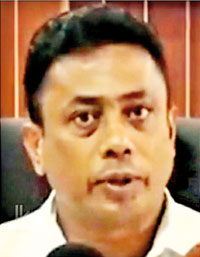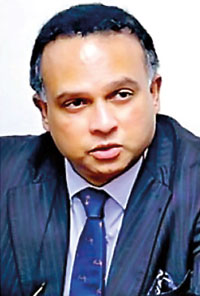Columns
Buvaneka’s assembly hall turns political circus ring
View(s):
THE 13TH CENTURY ARCHAEOLOGICAL RESERVE NOW 21ST CENTURY RUINS: Demolish first, answer questions later
It should have been a simple open and shut case.
A 13th century historical site, considered an archaeological reserve and protected under the Antiquities Ordinance of 1940, had been violated, bulldozed and reduced to rubble by an unknown gang of vandalisers in Kurunegala, with suspicion cast on the town’s mayor as the chief culprit. The Police should have investigated the matter, interrogated the suspects and, if satisfied as to their guilt, filed criminal charges in court for wanton destruction. Case closed.
But the authorities had not opted to walk the straight and narrow. Instead a circuitous route that meanders along streams and meadows, that winds its way up hills and descends through the dales, that ambles casually through corridors of power and loiters near urban town halls, reminiscent of the manner the Portuguese went to Kotte, had been followed for no explicable reason. The resultant ruckus, which has still not led to the arrest of a single suspect, makes one wonder what the ensuing fuss is all about.
Now for a brief recap of history. After the fall of Polonnaruwa as the capital of Lanka in 1214, Sinhala kings were forced to flee further south. From thenceforth, the Sinhala kings were made nomads in their own land, moving their kingdoms in their caravans and pitching camp for a few years at strategic bases. The descent had begun.

UNDER FIRE: Kurunegala Mayor Thushara Sanjeeva
First, the capital was established in Dambadeniya. Then came Yapahuwa, the rock fortress. Then it was moved to nearby Kurunegala, where it remained for fifty years before moving on again. Its first ruler was Buvenekbahu the II who reigned for only 9 years; and it is the assembly hall he had built that is at the very heart of the present furore.
This assembly hall had been demolished in the faceless secrecy of the night on July 14. When morning dawned and the town was agog over the destruction caused, the police had been duly informed but no action had been taken. Three days later, the Prime Minister appoints a five-member committee. They are given a week to submit their report on the incident.
Director-General of Archaeology Professor Senarath Dissanayake says his Department had filed a complaint with the Kurunegala Police immediately after part of the building was bulldozed on July 14. On Wednesday the Attorney General instructs the Acting IGP to launch a comprehensive investigation into the incident.
In the week that follows the destruction, political parties, too, get into the act. The UNP’s Ranil calls for the arrest of those responsible, Sajith’s SJB stage a protest at Colombo’s Lipton Circus over police inaction. Monks, too, join the fray and even those whose loyalties generally have been towards the ruling party, hold the Government accountable. BBS leader Gnanasara Thera criticises the Government and flays Prime Minister Rajapaksa’s reference to King Buvanekabahu as a man of many wives, the last one being a Muslim. He asks what is the relevance of that to the demolition of the building?
And the saga becomes curiouser and curiouser and is in danger of turning into a farce. To cap it all, the Kurunegala Mayor, Thushara Sanjeeva, admits on television to demolishing but denies any wrongdoing. “It is not from King Buvaneka’s time,” he says. “What we destroyed is a part of Hotel Buvaneka which had been illegally constructed.”
He says he has a letter from the RDA requesting him to demolish this part of the building to make for the RDA’s road expansion plans. “Buvaneka,” he says, “is the son of Chandrasiri, who occupied the premises on a 30-year lease from then UNP Minister Gamini Jayawickreme in1993.”
Meanwhile, the Mahinda-appointed committee gives its interim report on Thursday. It recommends: legal action against those responsible for the destruction.
 What a pity that this controversy did not erupt during the COVID curfew days. It would have kept the entertainment-starved masses enthralled. And what a tragedy the relatively obscure audience hall of a relatively unknown king had to surface now, two weeks before an all-important election to drown all debate and discussion on the real economic problems of present existence facing the masses.
What a pity that this controversy did not erupt during the COVID curfew days. It would have kept the entertainment-starved masses enthralled. And what a tragedy the relatively obscure audience hall of a relatively unknown king had to surface now, two weeks before an all-important election to drown all debate and discussion on the real economic problems of present existence facing the masses.
So, is it King Buvaneka’s audience hall that was destroyed or Chandrasiri’s son Buvaneka’s hotel bar that was demolished? Not to worry. With the Prime Minister playing the referee and wielding the magic wand, no doubt, he will wave it at the opportune time and settle the issue in a masterly manner, so that those who criticise him now for inaction will be forced to eat humble pie, with everyone else living happy ever after the August fifth polls day.
| Navin - a ‘cake climb’ up the greasy pole Unlike the dynastic bottle neck that exists in the Rajapaksa-dominated SLPP to throttle pretenders to the throne, it is the incumbent right of each and every member of the UNP to aspire to the topmost post in the party even before its present occupant had, by a nudge or a wink, shown any inclination of giving up the ghost. Thus when Navin Dissanayake — the son of former UNP leader, the suave, savvy Gamini Dissanayake who tragically died in a Tiger bomb blast whilst contesting the ‘95 presidential elections — lay early claim this week to the UNP crown, he was not only following in his beloved father’s footsteps but also exercising his inherent right as a member to chalk his slot in the long queue of aspirants to the UNP throne.  NAVIN: Throws down the gauntlet Speaking at a political meeting in Hatton, Navin Dissanayake said: “I am a straight-forward politician. I am one of the seniors in the party. I have been in the UNP for20 years. There are divisions in the party but I shall never leave the party. I joined Mahinda Rajapaksa’s SLFP for only three years to help end the 30-year war. I rejoined the UNP with the end of the war.” Hold on. Joined Mahinda Rajapaksa’s party to end the war? For only three years? Doesn’t that call for a correction? If only to put the record straight? It is uncertain whether Navin Dissanayake’s crossover from the defeated and depleted UNP benches in 2007 to join the triumphant SLFP’s swelling ranks contributed, even by a jot, to hasten the imminent end of Prabhakaran’s dimming star and bring the war to a close in 2009. No doubt the Armed Forces would have successfully ended the war, with or without his help. What is certain, however, is that he not only stayed with the Rajapaksa’s SLFP for three years as he claims but stayed the whole course for eight years ensconced in perks, privileges and position as a Minister of the SLFP Government. What is certain, furthermore, is how he helped strengthen Mahinda’s grip on power by his presence in the SLFP cheer squad when the draconian 18th Amendment to the Constitution, which rang the death knell to democracy, was passed in Parliament with 161 for and 17 against. He remained with the SLFP shaking the plum tree for himself until Mahinda called for presidential election in January 2015; and the pasture next door suddenly turned green. After Maithripala Sirisena had jumped ship on November 21, 2014 to become the opposition’s common candidate and the winds of fortune had begun blowing in the UNP’s Sirikotha direction, Navin abandoned the SLFP vessel leaving his Ministerial posts of Public Management and Reform on the burning deck, and rejoined the UNP in the last week of November. The arrival of the returning prodigal at Sirikotha was greeted by Ranil, who rewarded him with a cabinet ministership when forming the UNP government following Maithripala’s polls triumph in January. With the record set straight, what else did the ambitious 51-year-old Navin say last Sunday in Dimbula, Pathana? If party leader Ranil Wickremesinghe, 71, ever has sleepless nights worrying over what his former deputy Sajith is engineering from the outside to topple him from his UNP pedestal, he will start having nightmares when he hears what the Turk near his throne is openly conspiring. Navin Dissanayake revealed to his Hatton audience why Ranil had reached the world’s end as UNP leader. He declared in an adrenalin rush of ambition: “I think I can be the UNP leader. I will become the party leader and if I reach the top post of this country; the President or the Prime Minister, I will first work for the people of Nuwara Eliya. I have been in politics for 20 years, I am at the second or third position in the UNP and I want to become the number one.” “The United National Party is the oldest political party in the country and a large number of national leaders have emerged from this party,” he continued. “It was the UNP that worked for this country. However, as everyone knows, the UNP is divided today. The leadership of the UNP should change. The same person who has been leader for 26 years cannot continue to be the leader of the party.” Alas, poor Ranil. After having successfully thrown out one challenger to his leadership who has had to form his own party to survive in politics, he is now been told where to get off the bus by a former deserter of the party to boot. What next? The expected rout at the August 5 polls will be served fresh as further proof of his failures and help to seal his fate, with calls for his resignation from the party leadership growing more strident and, unless the survival savvy Ranil comes out with a Machiavellian plot and script to save his bacon, the final curtain will fall on a fading 26-year-performance, playing Jonah paying the wages of defeat. As for Navin, even if he delivers his unkindest cut of all to Ranil after polls, the UNP may not be that bankrupt of aspirants to allow him a ‘cakeclimb’ up the greasy pole. | |


Leave a Reply
Post Comment